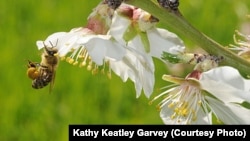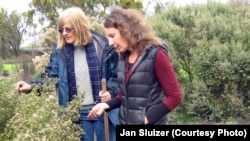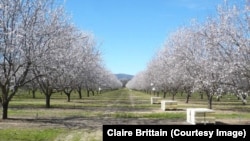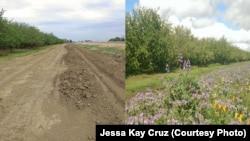Could the right mix of flowers, shrubs and grasses help resuscitate North America's rapidly declining bee populations? Researchers are trying to find out.
“With agricultural intensification, with urbanization, bees have lost so much of the habitat that they rely on for forage. Pollen and nectar make up 100 percent of these diets,” said Jessa Kay Cruz of the Xerces Society, an Oregon-based conservation group. “So they are totally dependent on certain types of flowers in order to survive.”
Finding the right mix
In an effort to identify the right combination that will bloom and attract bees throughout the spring and summer, and into the fall, Cruz and botanist Margaret Smither-Kopperl have set out a diverse mix of plants at the Lockeford Plant Materials Center in California's Central Valley. The center, which Smither-Kopperl manages, is one of more than two dozen U.S. Agriculture Department facilities around the country working to restore and sustain healthy ecosystems.
"We’ve spent a lot of time engineering different wildflower mixes so that there can be a mix that is specially designed for pollinators," Cruz explained. "Kind of layered on top of that, we have spent a lot of effort trying to research extremely drought-tolerant plants, because the drought is hitting people really, really hard and it’s something we are always thinking about — how do we establish these plants in really dry conditions.”
Among the plants in the mix are native coyote shrub brush, western redbuds and Oregon grape, which form hedgerows. Smither-Kopperl says the lines of bushes have been successful, not only in attracting bees, but in retaining water, which improves the soil.
“We did a study this summer and found that the water infiltration into our hedgerow area had tripled. So, in a bare field you might get runoff, you might get crusting, but the water, when it hits, will go right down into the hedgerow area and be available for the plants during the season.”
Where are the bees?
North America's 4,000 wild bee species and the imported European honey bee need help. The native bee population has been declining over the past four decades, and, since the winter of 2006, the puzzling Colony Collapse Disorder has been causing honeybees to mysteriously vanish.
"We know that beekeepers will go out and find their hives mysteriously empty, but they’re not necessarily finding a hive full of dead bees. There's just no bees,” Cruz said. On average, beekeepers are losing about a third of their hives every winter.
Originally imported to produce honey, the tiny insects also turned out to be excellent crop pollinators, becoming the foundation of a vital new agricultural industry.
“About eighty-five percent of the world’s flowering plants require a pollinator in order to reproduce," Cruz said. "In our agricultural ecosystems, about one in every three bites of food or drink that we consume requires pollinators."
Honeybeekeepers make their money by putting their hives on flatbed trucks each spring, and traveling to wherever crops are starting to bloom. Over 3,500 truckloads of bees arrived in California this month to pollinate almost one million acres of almond trees during their three-week bloom. Almonds are completely dependent on honey bees for pollination.
Helping farmers along with bees
Cruz and Smither-Kopperl also work with farmers, encouraging them to plant hedgerows and bee-attracting flora in areas that don’t hold crops, such as equipment storage yards, vehicle turn-a-rounds, and along roads and field borders. Smither-Kopperl says funding from the federal government can partly cover farmers' costs for these conservation measures.
Cruz calls it a successful program that is win-win for everyone.
“We are doing something for pollinators which are in decline. So we’re helping a declining species. And, in return for the farmer, they’re getting increased crop pollination services to their adjacent crops.”
Cruz and Smither-Kopperl stress that, so far, they have learned that biodiversity is the key to success. They also agree that there is still a long way to go before bee populations are flourishing again.








